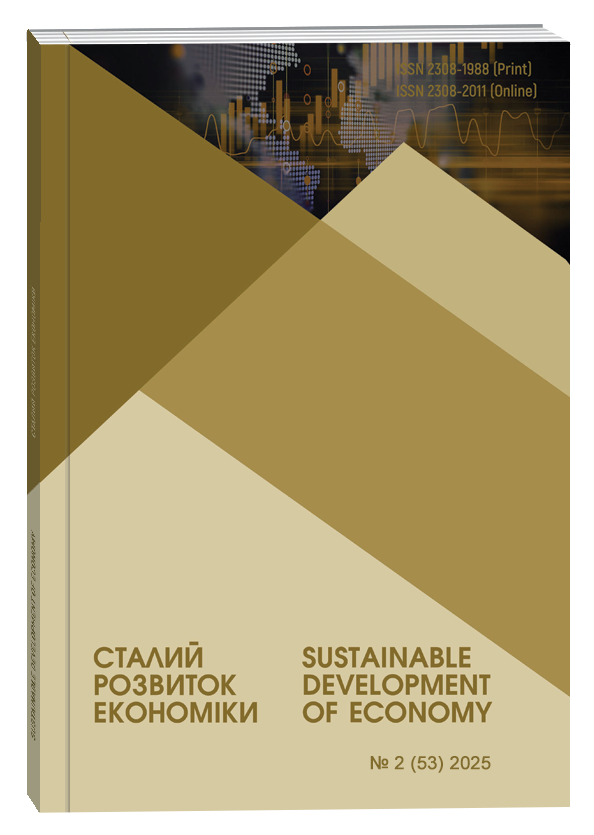METHODOLOGICAL APPROACH TO ASSESSING THE LEVEL OF SUSTAINABLE DEVELOPMENT IN THE IRON ORE INDUSTRY
Abstract
This article proposes a comprehensive methodology for assessing the sustainable development of the iron ore industry in Ukraine, addressing the critical need for integrated analysis in the context of global and domestic challenges. The developed approach combines the evaluation of ecological, socio-economic, market, and technological aspects, creating a robust framework for quantifying sustainability through the calculation of an integral indicator. This indicator reflects the balance and resilience of the industry, enabling a nuanced understanding of its development trajectory. The methodological framework includes key stages such as data collection and preparation, normalization of diverse indicators, calculation of composite indices for each subsystem, integration of these results into an overall assessment, and subsequent interpretation. The classification of sustainability levels, ranging from "critical" to "exemplary," provides a practical tool for identifying strengths and weaknesses within the sector. The algorithm ensures adaptability and scalability, making it applicable across varying industrial contexts. Through the analysis of data spanning 2018-2023, the study reveals dynamic fluctuations in the sustainability of Ukraine's iron ore sector. Key trends include moderate progress in certain aspects, alongside pronounced vulnerabilities, particularly in the ecological and socio-economic dimensions, exacerbated by the geopolitical crisis and war-related disruptions. The research highlights the necessity of strategic investments in environmental protection, innovation, and resilience-building measures to mitigate risks and foster balanced growth. The validation of the methodology demonstrates its practical relevance and potential to inform evidence-based decision-making at multiple levels, from policymakers to industry stakeholders. Additionally, the article underscores the broader applicability of the proposed approach as a tool for assessing sustainable development in other industrial sectors and regions. By providing actionable recommendations, the study contributes to bridging the gap between theoretical research and practical implementation in advancing sustainability goals.
References
Bansal P. Evolving sustainably: A longitudinal study of corporate sustainable development. Strategic management journal. 2005. No. 26(3), P. 197-218.
Cohen B., Winn M.I. Market imperfections, opportunity and sustainable entrepreneurship. Journal of business venturing. 2000. No. 22(1), P. 29-49.
Yellishetty M., Werner T.T., Weng Z. Iron ore in Australia and the world: Resources, production, sustainability, and future prospects. In Iron Ore. 2022. Pp. 711-750.
Alves W., Ferreira P.V., Araújo M. Sustainability assessment of the mining sector in Brazil. In 24th World Mining Congress. 2016. Pp. 439-451.
Сергєєв В.В., Копач П.І. Основні шляхи досягнення цілей сталого розвитку гірничо-металургійних регіонів. Екологія і природокористування. 2013. Вип. 16. С. 167-180.
Yu L., Pan Y., & Wu Y. Research on data normalization methods in multi-attribute evaluation. In 2009 International conference on computational intelligence and software engineering. 2009. Pp. 1-5.
Liu L., Hsu H. Inversion and normalization of time-frequency transform. International conference on multimedia technology. 2011. Pp. 2164-2168.
Schwab B., JanzenS., Magnan N.P., Thompson W.M. Constructing a summary index using the standardized inverse-covariance weighted average of indicators. The Stata Journal. 2020. No. 20(4), Pp. 952-964.
Bansal P. (2005). Evolving sustainably: A longitudinal study of corporate sustainable development. Strategic management journal, no. 26(3), pp. 197-218.
Cohen B., & Winn M. I. (2007). Market imperfections, opportunity and sustainable entrepreneurship. Journal of business venturing, no. 22(1), pp. 29-49.
Yellishetty M., Werner T. T., & Weng Z. (2022). Iron ore in Australia and the world: Resources, production, sustainability, and future prospects. In Iron Ore (pp. 711-750). Woodhead Publishing.
Alves W., Ferreira P. V., & Araújo M. (2016). Sustainability assessment of the mining sector in Brazil. In 24th World Mining Congress (pp. 439-451). Rio de Janeiro: World Mining Congress.
Serhieiev V. V., Kopach P. I. (2013) Osnovni shliakhy dosiahnennia tsilei staloho rozvytku hirnycho-metalurhiinykh rehioniv [Main ways to achieve the goals of sustainable development of mining and metallurgical regions]. Ekolohiia i pryrodokorystuvannia – Ecology and nature management. vol. 16. pp. 167-180. (in Ukrainian)
Yu L., Pan Y., & Wu Y. (2009). Research on data normalization methods in multi-attribute evaluation. In 2009 International conference on computational intelligence and software engineering (pp. 1-5). IEEE.
Liu L., & Hsu H. (2011, July). Inversion and normalization of time-frequency transform. In 2011 international conference on multimedia technology (pp. 2164-2168). IEEE.
Schwab B., Janzen S., Magnan N.P., & Thompson W.M. (2020). Constructing a summary index using the standardized inverse-covariance weighted average of indicators. The Stata Journal, no. 20(4), pp. 952-964.


